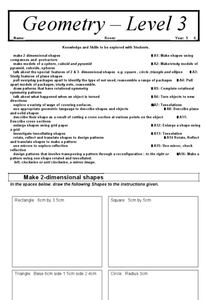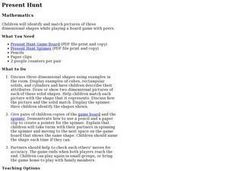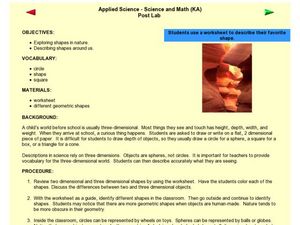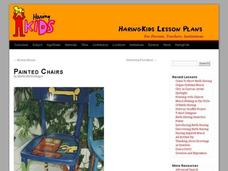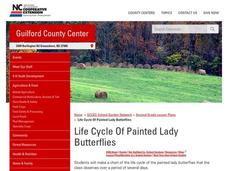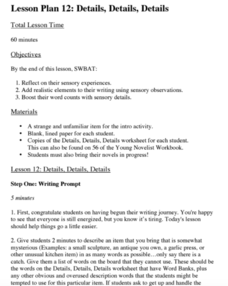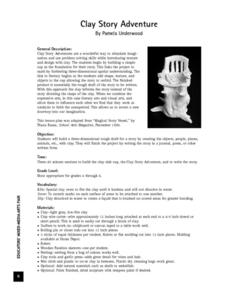Curated OER
Three- and Two- Dimensional Geometry
In this three- and two- dimensional geometry worksheet, 7th graders solve 12 various problems related to geometric shapes and measurement. They first use paper and a pencil to sketch the front, side, back, top and bottom views of each...
Curated OER
Geometry Level 3
What a wonderful resource! Learners create two-dimensional shapes according to the instructions stated, use the squares to make a triangular prism, a cube, and a pyramid, and identify features of plane shapes, among a myriad of other...
Curated OER
Marshmallow Geometry
In this three-dimensional shapes geometry lesson, learners identify geometric solids and name their properties. They define "face," "edge," and "vertex," and construct geometric solids using marshmallows as vertices and toothpicks as edges.
Curated OER
3-D Figures Part 2
Students work with three dimensional objects. In this geometry lesson, students examine models of spheres, cones, cubes, prisms, and pyramids, and identify them by their edges, vertices, and faces.
Curated OER
Present Hunt
Students identify and match pictures of three dimensional shapes while playing a board game with peers. They take turns with their partners in spinning the spinner and moving to the next space on the game board that shows the same shape.
Curated OER
3-D Figures Part 1
Elementary schoolers explore 3-D shapes. They transition from thinking of shapes as only 2-D. Pupils read Cinderella as a launching activity for their upcoming adventure, and explore a new world of 3-D shapes in this introductory lesson.
Curated OER
Applied Science: Exploring Shapes in Nature
Explore geometry with your young mathematicians! First, have them color in different two-dimensional and three-dimensional shapes. Then take them on a walk around the classroom. Can they identify different shapes using the target...
Curated OER
Painted Chairs
Students evaluate visual arts by creating furniture designs. For this three dimensional art lesson, students utilize the web to examine different artist renderings of furniture, sculpture and architecture. Students utilize paint to...
NC Cooperative Extension, Guilford County Center
Life Cycle Of Painted Lady Butterflies
The Very Hungry Caterpillar is the inspiration for this project-based learning activity. Kindergartners create a lifecycle chart for a butterfly with four sections: egg, caterpillar, pupa, and butterfly. It is a three-dimensional...
Curated OER
Visual Arts: Art in Public Places
Students create 3 dimensional art. In this sculpture lesson, students collect objects that represent their community's values to include in a 3 dimensional sculpture. Students write a paragraph explaining the chosen theme of their...
Curated OER
Cooler in the Shadows
Students explore Earth science by creating a scale model in class. In this shadow lesson, students research the impact the sun has on Earth shadows and complete a space science worksheet. Students create models of the Sun and Earth and...
Curated OER
Dream Bed
Students view and discuss two beds in the Getty collection and design and write descriptions of imaginary beds. In this imagery beds lesson plan students have to describe and compare/contrast works of art, orally and in writing. They...
Curated OER
Experiencing 3D
Students explore photography by utilizing digital cameras. In this 3 dimensional instructional activity, students create eye glasses using red and blue acetate in order to view 3-D images. Students utilize computers and digital cameras...
Curated OER
How Do You Know A Panther Was Here?
Students research the signs that panthers leave. In this panther track lesson, students conduct Internet research into the signs that panthers leave such as tracks, scat, scrapes, and scratches. They make a three-dimensional poster using...
Curated OER
Four Estimating the Area of Small Objects Problems
In this estimating area worksheet, students work with their families to draw four small objects found around their house and estimate the area of each object.
Curated OER
Details, Details, Details
Writing can become one-dimensional if authors don't involve all their senses. First, scholars observe a strange object which, ideally, they can touch and even smell. Without using certain words (you can create a list or have the class...
Curated OER
Clay Story Adventure
Students build three-dimensional rough draft for a story by creating objects, people, places, animals, etc., with clay, and write story in a journal, poem, or other written form.
Curated OER
Design Your Dream Room
Students determine length, width, perimeter, and surface area, and work with two-dimensional representations of three-dimension objects to design and write descriptions of their dream bedrooms.
Curated OER
Compare 2-D Shapes
Second graders examine the attributes of two-dimensional shapes. In this geometry lesson plan, 2nd graders play a game in order to identify two-dimensional shapes and to name them.
Curated OER
Comparing Measurements
Students explore measurements by completing worksheets in class. For this geometry lesson, students identify the basic measurement units in both the English and metric systems. Students analyze 2 and 3 dimensional objects and identify...
Curated OER
Seeing through Touch
Students explore solid objects using touch. In this art lesson, students are blindfolded and given a 3 dimensional object to explore with their hands. After the object is removed, students draw what they think the object looked like....
Curated OER
Ocean Exploration: Shapes and Patterns Under the Sea
So many shapes in our vast oceans. Young explorers can discover new shapes in a variety of ways in this lesson. One way is having free exploration with a pattern shape kit handed out by the teacher. Another is by viewing a...
Curated OER
Shape Hunt
Young scholars explore two-dimensional and solid shapes. In this shapes and patterns geometry lesson, students work with a partner to create identifiable objects using tangrams. Young scholars describe the attributes of their shape and...
Curated OER
Sun, Shadows, Surface Structure...and the Face on Mars
Students use light and shadow information to make inferences regarding the three dimensional shapes of specific objects photographed on the surface of Mars. Limitations of the of the data provided are discussed and entries made into the...

